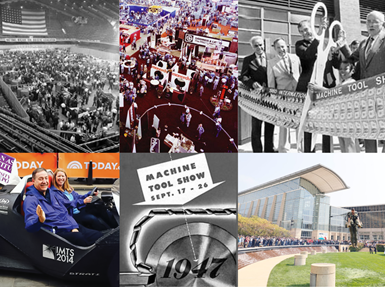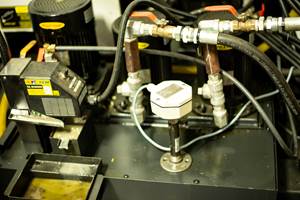What Year Did a Robot Hand First Debut at IMTS?
Did you know that the show was postponed for WWII? Or that McCormick Place was expanded in the ’70s just to accommodate IMTS? A fascinating look at the show’s history from 1927 to today.
IMTS 1929: Held in Cleveland from Sept. 30 to Oct. 4, 1929, this NMTBE displayed about 200 new items and highlighted the application of tungsten-carbide cutting tools. Over 25,000 visitors were in attendance.
IMTS 1935: Postponed due to Great Depression business conditions, the 1935 NMTBE took place in Cleveland from Sept. 11-21.
IMTS 1947: Postponed due to World War II, the show’s name was changed to the 1947 Machine Tool Show, taking place from Sept. 17-26 in Chicago. All machines were required to be painted “machine tool gray.”
IMTS 1955: The 1955 Machine Tool Show took place in Chicago, with a concurrent Production Engineering Show held at Navy Pier with a shuttle bus provided to move between the two shows.
IMTS 1960: The 1960 Machine Tool Show took place in Chicago, with a focus on adapting the electronic computer to design machines to respond to instructions coded in number form on punched or magnetic tape and transmitted electronically to servo-mechanisms that operate the machine tool. The Production Engineering Show and 2nd International Coliseum Machinery Show also took place during this time.
IMTS 1965-1970: The 1965-1970 Machine Tool and Production Engineering Shows in Chicago marked the end of the “twin shows.” It was the first international exhibition of machine tools and related products from major nations around the world.
IMTS 1972: The 1972 International Machine Tool Show marked the first show with international exhibitors, on a two-year cycle, and located at McCormick Place in Chicago.
IMTS 1974-1976: Held in Chicago, these shows highlighted numerical control capabilities, as well as growing computerized technologies.
IMTS 1978: McCormick Place was expanded to accommodate the entire trade show at one location.
IMTS 1980-1988: Attendance skyrocketed and broke records. In 1982, Technical Conference sessions were added. In 1988, the robot hand was introduced.
IMTS 1990: The name of the show was officially changed to The International Manufacturing Technology Show (IMTS). The Forming and Fabricating Pavilion was also introduced.
IMTS 1992: The Expocard system was introduced, making it easier and faster for visitors to request information and for exhibitors to gather data on potential customers.
IMTS 1994: Hexapod machine design technology was introduced through Variax, Giddings & Lewis Inc.’s version of these six-legged machine tools. Controls, often based on PCs, were growing faster, more accurate and easier to use.
IMTS 1996-1998: At IMTS 1996, linear motors enabled machines to operate at growing rates. Both IMTS 1996 and 1998 saw expansion at McCormick Place.
IMTS 2000: More than 100,000 visitors were in attendance. IMTS.com enabled exhibitors to purchase advertising packages and visitors were able to pre-plan their show visit.
IMTS 2002: Due to the poor manufacturing economy at the time, attendance dwindled to just over 85,000 visitors, but more than 1,350 exhibitors appeared, focusing on quality and cost-effectiveness.
IMTS 2004-2006: IMTS 2004 marked the 25th anniversary of IMTS and introduced the Emerging Technology Center (ETC) and the Student Summit. Over 85,000 visitors were in attendance at IMTS 2004, with more than 90,000 visitors at IMTS 2006.
IMTS 2008: The show became a six-day event with over 90,000 visitors in attendance. It introduced software standard MTConnect, an advanced manufacturing center and the new innovation center.
IMTS 2010: The ETC featured MTConnect and its iPhone app, as well as advances in additive manufacturing, cloud computing, advanced manufacturing, virtual reality and micro- and nano-manufacturing. IMTS 2010 also introduced the Manufacturing Museum and Industry Inspiration Day. Over 80,000 visitors were in attendance.
IMTS 2012: Additive manufacturing, multi-spindle and multi-tasking machines were highlights of the show. It hosted six educational conferences, the first Job Center, Today’s Technology Center and Student Skills Center. Over 100,000 visitors were in attendance.
IMTS 2014: The first-ever electric car was 3D printed and assembled on the show floor, the Strati. The Industrial Automation North America (NA) and Motion, Drive & Automation North America shows were co-located at IMTS 2014. The Miles for Manufacturing 5K was held. Over 110,000 visitors were in attendance.
IMTS 2016: Additive manufacturing, robotics automation and an increasing digital thread were the primary focus. Numerous companies introduced equipment with Industrial Internet of Things (IIot) capabilities. The IMTS Ride Experience highlighted a self-driving car. Top Shops created a space for shop owners and managers to converse about emerging technologies. Over 115,000 visitors were in attendance.
IMTS 2018: Noted as a year of digital transformation due to additive manufacturing advances, a focus on IIoT and 71 different conference sessions. The Hannover-Messe co-located show hosted 510 international exhibitors, with information sessions on the growing technology and IIoT. Over 125,000 visitors were in attendance.
IMTS 2022: The Women Make Manufacturing Move program and IMTS Investor Forum were introduced to the show. Cobots and integrated robots were highlighted, as well as the largest Student Summit and full programming on the IMTS+ Main Stage. Over 85,000 visitors were in attendance.

Related Content
Same Headcount, Double the Sales: Successful Job Shop Automation
Doubling sales requires more than just robots. Pro Products’ staff works in tandem with robots, performing inspection and other value-added activities.
Read MoreHow to Accelerate Robotic Deburring & Automated Material Removal
Pairing automation with air-driven motors that push cutting tool speeds up to 65,000 RPM with no duty cycle can dramatically improve throughput and improve finishing.
Read MoreManaging Coolant with Skimmers, Refractometers and More
Bacteria-infected coolant harms machines and sickens machinists. Coolant management technologies like skimmers and automated systems counter this tendency.
Read MoreWhich Approach to Automation Fits Your CNC Machine Tool?
Choosing the right automation to pair with a CNC machine tool cell means weighing various factors, as this fabrication business has learned well.
Read MoreRead Next
The Future of High Feed Milling in Modern Manufacturing
Achieve higher metal removal rates and enhanced predictability with ISCAR’s advanced high-feed milling tools — optimized for today’s competitive global market.
Read MoreRego-Fix’s Center for Machining Excellence Promotes Collaboration
The new space includes a showroom, office spaces and an auditorium that will enhance its work with its technical partners.
Read MoreRegistration Now Open for the Precision Machining Technology Show (PMTS) 2025
The precision machining industry’s premier event returns to Cleveland, OH, April 1-3.
Read More


























